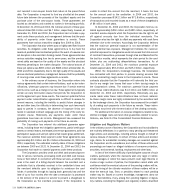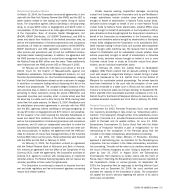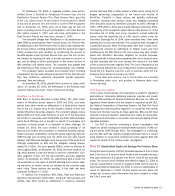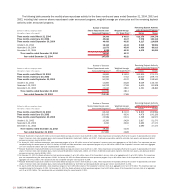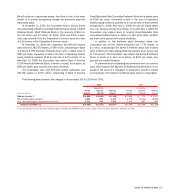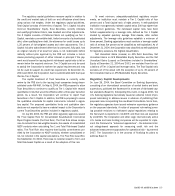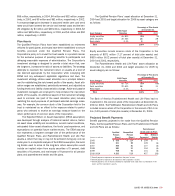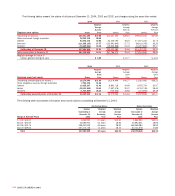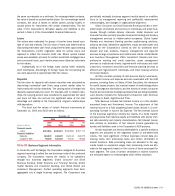Bank of America 2004 Annual Report Download - page 136
Download and view the complete annual report
Please find page 136 of the 2004 Bank of America annual report below. You can navigate through the pages in the report by either clicking on the pages listed below, or by using the keyword search tool below to find specific information within the annual report.
BANK OF AMERICA 2004 135
The regulatory capital guidelines measure capital in relation to
the credit and market risks of both on- and off-balance sheet items
using various risk weights. Under the regulatory capital guidelines,
Total Capital consists of three tiers of capital. Tier 1 Capital includes
Common Shareholders’ Equity, Trust Securities, minority interests
and qualifying Preferred Stock, less Goodwill and other adjustments.
Tier 2 Capital consists of Preferred Stock not qualifying as Tier 1
Capital, mandatory convertible debt, limited amounts of subordinated
debt, other qualifying term debt, the allowance for credit losses up to
1.25 percent of risk-weighted assets and other adjustments. Tier 3
Capital includes subordinated debt that is unsecured, fully paid, has
an original maturity of at least two years, is not redeemable before
maturity without prior approval by the FRB and includes a lock-in
clause precluding payment of either interest or principal if the pay-
ment would cause the issuing bank’s risk-based capital ratio to fall or
remain below the required minimum. Tier 3 Capital can only be used
to satisfy the Corporation’s market risk capital requirement and may
not be used to support its credit risk requirement. At December 31,
2004 and 2003, the Corporation had no subordinated debt that qual-
ified as Tier 3 Capital.
The capital treatment of Trust Securities is currently under
review by the FRB due to the issuing trust companies being decon-
solidated under FIN 46R. On May 6, 2004, the FRB proposed to allow
Trust Securities to continue to qualify as Tier 1 Capital with revised
quantitative limits that would be effective after a three-year transition
period. As a result, the Corporation will continue to report Trust
Securities in Tier 1 Capital. In addition, the FRB is proposing to revise
the qualitative standards for capital instruments included in regula-
tory capital. The proposed quantitative limits and qualitative stan-
dards are not expected to have a material impact to the Corporation’s
current Trust Securities position included in regulatory capital.
On July 28, 2004, the FRB and other regulatory agencies issued
the Final Capital Rule for Consolidated Asset-backed Commercial
Paper Program Assets (the Final Rule). The Final Rule allows compa-
nies to exclude from risk-weighted assets, the assets of consolidated
ABCP conduits when calculating Tier 1 and Total Risk-based Capital
ratios. The Final Rule also requires that liquidity commitments pro-
vided by the Corporation to ABCP conduits, whether consolidated or
not, be included in the capital calculations. The Final Rule was effec-
tive September 30, 2004. There was no material impact to Tier 1 and
Total Risk-based Capital as a result of the adoption of this rule.
To meet minimum, adequately-capitalized regulatory require-
ments, an institution must maintain a Tier 1 Capital ratio of four
percent and a Total Capital ratio of eight percent. A well-capitalized
institution must generally maintain capital ratios 200 bps higher than
the minimum guidelines. The risk-based capital rules have been
further supplemented by a leverage ratio, defined as Tier 1 Capital
divided by adjusted quarterly average Total Assets, after certain
adjustments. The leverage ratio guidelines establish a minimum of
three percent. Banking organizations must maintain a leverage capital
ratio of at least five percent to be classified as well-capitalized. As of
December 31, 2004, the Corporation was classified as well-capitalized
for regulatory purposes, the highest classification.
Net Unrealized Gains (Losses) on AFS Debt Securities, Net
Unrealized Gains on AFS Marketable Equity Securities and the Net
Unrealized Gains (Losses) on Derivatives included in Shareholders’
Equity at December 31, 2004 and 2003, are excluded from the cal-
culations of Tier 1 Capital and leverage ratios. The Total Capital ratio
excludes all of the above with the exception of up to 45 percent of
Net Unrealized Gains on AFS Marketable Equity Securities.
Regulatory Capital Developments
On June 26, 2004, the Basel Committee on Banking Supervision,
consisting of an international consortium of central banks and bank
supervisors, published the framework for a new set of risk-based cap-
ital standards (Basel
II
). Anticipating this event, in August 2003, the
U.S. banking regulators had already issued an advance notice of pro-
posed rulemaking to address issues in advance of publishing their
proposed rules incorporating the new Basel
II
standards. Since then,
the regulatory agencies have issued extensive supervisory guidance
on the proposed standards. A notice of proposed rule-making cover-
ing possible revisions to risk-based capital regulations relating to
the framework is expected in mid-2005; and final rules are expected
by mid-2006. The Corporation and other large internationally active
U.S. banks and bank holding companies will be expected to imple-
ment the framework’s “advanced approaches” – the advanced inter-
nal ratings-based approach for measuring credit risk and the
advanced measurement approaches for operational risk – by year-end
2007. The Corporation is in the process of finalizing its plans to
address Basel
II
.



